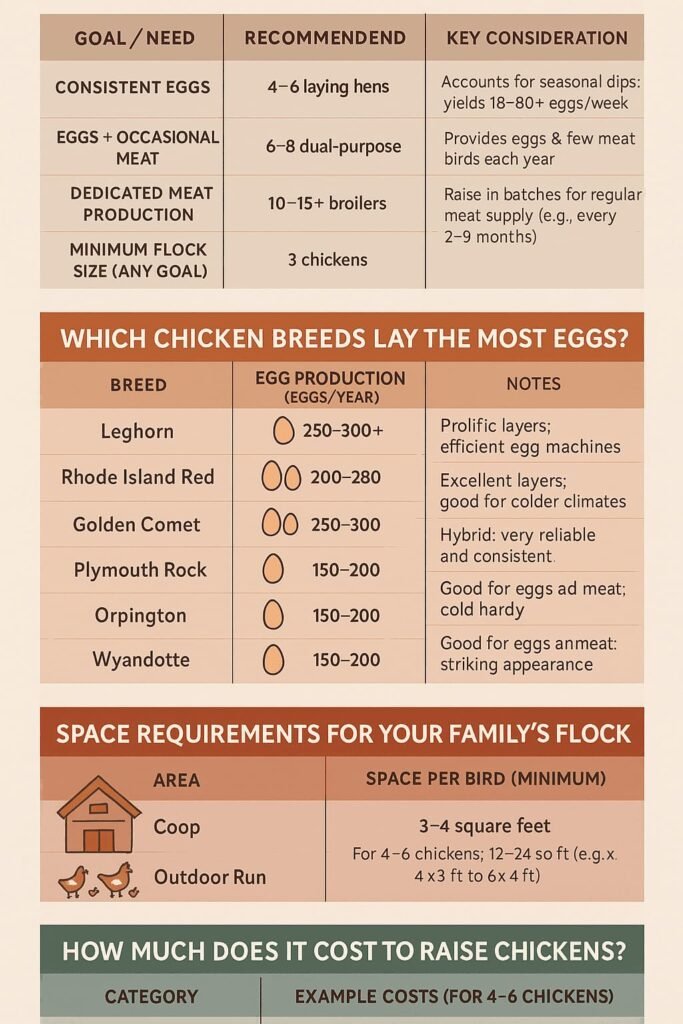So, you’ve got the chicken bug, huh? And like many aspiring backyard chicken keepers, you’re probably wondering, “How many chickens do you need for a family of 4?” It’s a fantastic question, and one I wrestled with myself when I first started out. The short answer is: it depends, but typically, a family of four looking for a consistent supply of fresh eggs will do well with 4 to 6 laying hens.
But let’s be real, “it depends” isn’t exactly the concrete answer you’re looking for, is it? It’s like asking “How much chocolate do I need?” – the answer changes if you’re a casual nibbler or a full-blown chocoholic! Deciding on the right flock size involves more than just a quick calculation. It’s about balancing your family’s needs, your available space, the time you can commit, and even your climate. Let’s dive deep into all the juicy details so you can confidently plan your perfect backyard flock.
TL;DR: Quick Answers for a Family of 4
| Goal / Need | Recommended Chickens | Key Consideration |
|---|---|---|
| Consistent Eggs | 4-6 laying hens | Accounts for seasonal dips; yields 18-30+ eggs/week. |
| Eggs + Occasional Meat | 6-8 dual-purpose | Provides eggs & a few meat birds each year. |
| Dedicated Meat Production | 10-15+ broilers | Raise in batches for regular meat supply (e.g., every 2-3 months). |
| Minimum Flock Size (Any Goal) | 3 chickens | Chickens are social; avoid keeping just one or two. |
Consider Your Family’s Egg Consumption Habits
To figure out how many chickens you need for a family of 4, start by honestly assessing your family’s actual egg consumption. This is critical to avoid over-production.
- Average Egg Consumption: The average person consumes about 2-3 eggs per week. For a family of four, that’s roughly 8-12 eggs per week. But are you “average”? My family, for example, loves eggs. We’re talking scrambled eggs for breakfast, hard-boiled eggs for snacks, and quiches for dinner. We easily go through 18-24 eggs a week. So, for us, two chickens wouldn’t even cover a single weekend!
- Daily Egg Eaters vs. Occasional: Do some family members eat eggs daily, like clockwork, while others only occasionally? Or are you a household that bakes a lot, constantly needing eggs for cakes, cookies, and casseroles? If you’re heavy bakers or simply egg enthusiasts, you’ll need a more robust supply. Think of it as a personalized egg production line!
- Storing Excess Eggs: Fresh, unwashed eggs can last for several weeks (even months!) on the counter, or longer in the fridge. Pretty cool, right? Think about your storage capacity. If you don’t mind having a surplus for a while, perhaps even sharing with neighbors (who will instantly become your best friends!), you might lean towards a slightly larger flock. If you want just enough, no fuss, no muss, then aim for a precise number.
How many eggs does a family of 4 actually eat? That’s for you to figure out by tracking for a week or two! Grab a notebook, and start counting. You might be surprised! Do I need a constant supply? If yes, factor in seasonal dips in production. Because nobody wants an egg drought!
Which Chicken Breeds Lay the Most Eggs?
If eggs are your priority, focus on high-producing chicken breeds like Leghorns, Rhode Island Reds, or Golden Comets. These breeds are egg-laying machines and a key factor in flock size. Don’t pick a breed based solely on how pretty their feathers are – unless you’re just looking for garden decorations, of course!
| Breed | Egg Production (Eggs/Year) | Egg Color | Temperament | Notes |
|---|---|---|---|---|
| Leghorn | 250-300+ | White | Active, Flighty | Prolific layers, efficient egg machines. |
| Rhode Island Red | 200-280 | Brown | Hardy, Assertive | Excellent layers, good for colder climates. |
| Golden Comet | 250-300 | Brown | Docile, Friendly | Hybrid, very reliable and consistent. |
| Plymouth Rock | 150-200 | Brown | Calm, Dual-purpose | Good for eggs and meat, cold hardy. |
| Orpington | 150-200 | Brown | Gentle, Broody | Good backyard pet, dual-purpose. |
| Wyandotte | 150-200 | Brown | Calm, Cold-Hardy | Good for eggs and meat, striking appearance. |
- Factors Affecting Egg Production: Remember, a chicken isn’t a factory. Egg laying is influenced by:
- Age: Pullets (young hens, typically 18-24 weeks old) start laying consistently. Production peaks in their first two years and then gradually declines. They’re like young athletes at the top of their game!
- Season: Hens lay less in winter due to shorter daylight hours. This is where having a few extra birds can bridge the gap if you rely solely on your flock for eggs. Otherwise, prepare for some store-bought eggs during the colder months – gasp!
- Health & Feed: A healthy hen with a balanced, high-quality layer feed will be a better producer. Think of it as premium fuel for premium eggs!
- Pullets vs. Older Hens: When you start, consider buying pullets close to laying age for immediate egg gratification. Who wants to wait, right? Older hens might be cheaper but will lay fewer eggs. Sometimes, instant gratification is worth the extra cost.
Which chicken breeds are best for eggs? For consistent production, go for Leghorns, Rhode Island Reds, or Golden Comets. How many eggs does one chicken lay per week? High producers typically lay 4-6 eggs per week during their peak, but average around 3-5 eggs over the year due to seasonal and age variations. It’s like hoping for a home run every time, but a consistent base hit is still pretty great!
Beyond Eggs: Meat Production for a Family of 4
If the thought of truly homegrown chicken dinners is making your mouth water, consider raising broiler breeds like Cornish Cross for efficient meat production. This changes the “how many chickens do you need for a family of 4” equation significantly. We’re talking about a whole different ballgame here!
- Broiler Breeds vs. Dual-Purpose:
- Broiler breeds (like Cornish Cross) are specifically bred for rapid growth and meat production. They’re the sprinters of the chicken world, reaching processing weight (4-6 lbs) in just 8-10 weeks. If you’re focused purely on meat, these are your go-to. They’re not winning any beauty contests, but boy do they grow!
- Dual-purpose breeds (like Plymouth Rocks, Wyandottes, or Orpingtons) provide both eggs and meat, but grow slower and won’t yield as much meat as broilers. They take 4-5 months to reach a good size. They’re the all-rounders, good for a bit of everything.
- Meat Yield: A Cornish Cross broiler typically yields 3-5 lbs of dressed meat. For a family of 4 wanting chicken once a week, you’d need about 52 chickens per year. Suddenly, “how many chickens do you need for a family of 4” sounds like a very big number!If you process them in batches (say, 10-15 every 2-3 months), you’d need around 10-15 birds at a time.
- Freezing and Storing Meat: You’ll need substantial freezer space! A typical chest freezer can hold a decent number of processed birds, but plan accordingly. Don’t underestimate this; you don’t want a freezer full of delicious chicken with nowhere to put it!
Can I raise enough meat chickens for my family? Absolutely, but it requires more planning, processing, and space than just an egg-laying flock. It’s a commitment, but the reward of knowing exactly where your dinner came from is huge. What breeds are good for meat? Cornish Cross for dedicated meat, or dual-purpose like Plymouth Rock or Wyandotte if you want eggs too.

Space Requirements for Your Family’s Flock
For healthy chickens, plan for at least 3-4 square feet of coop space and 8-10 square feet of outdoor run space per bird. Cramped conditions lead to stress, disease, and behavioral issues like feather-picking. Imagine living in a tiny studio apartment with three other people and no balcony – that’s how chickens feel in an overcrowded coop!
| Area | Space Per Bird (Minimum) | Notes |
|---|---|---|
| Coop | 3-4 square feet | For 4-6 chickens: 12-24 sq ft (e.g., 4×3 ft to 6×4 ft). More is better! |
| Outdoor Run | 8-10 square feet | For 4-6 chickens: 32-60 sq ft. Essential for foraging & exercise. |
| Perch/Roost | 8-12 inches | Per bird. Chickens sleep on these at night. |
| Nesting Box | 1 box per 3-4 hens | For 4-6 chickens: 2 boxes should be enough. |
- Impact of Flock Size on Space: Simply put, more chickens equal more required space. Don’t try to squeeze 10 chickens into a coop meant for 4. Overcrowding is a recipe for disaster, turning your peaceful flock into a stressed-out mob. Trust me, it’s not pretty.
How much space do chickens need? Inside the coop, chickens need a minimum of 3-4 square feet per bird. In the outdoor run, aim for 8-10 square feet per bird. What size coop for how many chickens? For a family of 4’s needs (4-6 chickens), a coop around 16-24 sq ft is a good starting point, plus a run of 40-60 sq ft. Give them room to breathe (and cluck!).
Time and Effort: Managing Your Chickens for a Family of 4
Caring for chickens isn’t a set-it-and-forget-it deal, but it’s also not a full-time job. The time commitment scales with your flock size, so think about what you can realistically handle. Expect to spend 15-30 minutes daily on basic chores for a small flock.
- Daily Chores (15-30 minutes):
- Feeding and Watering: This is paramount. Fresh food and water daily. Automated feeders and waterers can cut down on this time significantly, turning a chore into a quick check.
- Egg Collection: A quick trip to the coop to gather those warm, fresh eggs! This is usually the most rewarding part of the day, like finding little treasures.
- Quick Health Check: Observe your birds. Are they moving well? Eating? Any unusual behavior? You’ll quickly learn their quirks, and a quick daily glance can catch problems early.
- Weekly Chores (1-2 hours):
- Coop Cleaning: Removing soiled bedding and replenishing. A “deep litter” method can extend this to monthly, which is a lifesaver for busy folks.
- Run Maintenance: Raking, rotating areas, or adding fresh dirt/sand. Keeps things tidy and healthy.
- Monthly/Seasonal Chores (Varies):
- Deep Cleaning: Thorough scrubbing of the coop. Think spring cleaning, but for chickens.
- Predator Protection: Checking for any weak spots in your fencing or coop. I learned this the hard way when a crafty raccoon found a tiny gap in our run – never again! The heartbreak of losing a bird is something you want to avoid at all costs.
- Health Checks: More thorough inspections for mites, lice, or other issues. A little preventative care goes a long way.
- The Impact of More Chickens on Time Commitment: While more birds mean more eggs/meat, they also mean more waste (oh, the waste!), more feed consumed, and potentially more health issues to monitor. Going from 4 to 10 chickens more than doubles the waste, even if daily feeding time only slightly increases. Are you up for the challenge?
How much time does it take to care for chickens? For 4-6 birds, expect 15-30 minutes daily, plus a few hours weekly/monthly. Is a larger flock significantly more work? Yes, proportionally, especially when it comes to cleaning and feed consumption. Your shovel will become your new best friend.
Expert Tips for efficient chicken management:
- Automate: Invest in large-capacity feeders and waterers. Trust me, future you will thank you!
- Deep Litter Method: Build up wood shavings and turn them regularly. This creates a natural composting system that reduces cleaning frequency. It’s surprisingly effective.
- Strategic Coop Design: Make sure your coop is easy to access for cleaning. Raised coops are a lifesaver for your back! No more crouching in tiny spaces.
How Much Does It Cost to Raise Chickens?
Starting a backyard flock involves initial costs and ongoing expenses. Expect initial setup costs between $300-$800+, and ongoing monthly expenses of $30-$60 for a small flock. How many chickens do you need for a family of 4 also factors into your budget. It’s not just about the cute chicks; it’s about the long-term investment.
| Category | Example Costs (for 4-6 chickens) | Notes |
|---|---|---|
| Initial Setup | Coop: $300-$1000+ | Can be DIY or pre-built. |
| Chicks/Pullets: $3-$30 each | Chicks are cheaper, pullets lay sooner. | |
| Feeders & Waterers: $30-$100 | Essential equipment. | |
| Bedding (initial): $20-$40 | Start-up supply. | |
| Ongoing (Monthly) | Feed: $20-$40 (50lb bag) | Your biggest recurring cost. |
| Bedding: $10-$20 | Regular replenishment. | |
| Health Supplies: $5-$15 | Grit, oyster shell, occasional supplements. | |
| Miscellaneous: Varies | Pest control, electricity for winter lights (if used). |
- Potential Savings: While there’s an upfront investment, fresh eggs from your own flock are virtually free after the initial costs. And if you raise meat birds, you’re saving significantly on grocery store prices. Can you put a price on knowing exactly where your food comes from, anyway? I think not!
How much does it cost to start a flock? Expect $300-$800+ for a basic setup. What are the recurring expenses? Primarily feed and bedding, averaging around $30-$60 per month for a small flock. It’s an investment, but a rewarding one!
Common Mistakes to Avoid When Planning Your Flock Size
When I started, I made a few blunders. Learning from others’ mistakes (or mine!) is always easier and a lot less frustrating. The most common errors involve underestimating space, overestimating egg consumption, and impulse buying. Consider these as friendly warnings from someone who’s been there, done that, and probably cleaned up a lot of chicken mess.
- Underestimating Space Needs: This is probably the most common mistake. People buy a cute little coop that says “for 6 chickens” but it’s really meant for 2. Overcrowding leads to stress, bullying, and disease. Always give more space than the minimum recommended. Your chickens deserve a decent amount of personal space, just like you do!
- Overestimating Egg Consumption: You might think you need a dozen eggs a day, but unless you’re feeding a small army, you’ll likely end up with a huge surplus. Be realistic about your family’s actual needs. Or, be prepared to become the neighborhood’s favorite egg dealer!
- Not Accounting for Roosters (if applicable): If you hatch your own eggs or buy “straight run” chicks, you might end up with roosters. They don’t lay eggs, can be noisy (prepare for early morning crowing!), and multiple roosters can fight. Plan how you’ll manage them. It’s a surprise bonus you might not want!
- Impulse Buying Too Many Chicks: They’re adorable, I know! Those tiny chirps and fluffy bodies are irresistible. But resist the urge to buy every fluffy chick you see. Stick to your plan for how many chickens you need for a family of 4, or you’ll quickly be overwhelmed. I once started with too many chicks because they were “on sale” – it turned into a comical, but messy, learning experience in population control! My backyard looked like a feathered disco!
Seasonal Considerations and Flock Management
The seasons play a big role in your chickens’ productivity and your management. It’s like gardening; you wouldn’t expect tomatoes in winter, right? Expect egg production to fluctuate with the seasons, especially dropping in fall and winter.
| Season | Egg Production Impact | Care Considerations |
|---|---|---|
| Spring/Summer | Peak Production | Ensure shade, plenty of cool water, good ventilation. |
| Fall | Production slowly drops | Prepare for colder weather, may start molting (less laying). |
| Winter | Significantly lower (or stop) | Provide warmth (if needed), extra feed, fresh unfrozen water. |
- Heat Stress in Summer: Chickens don’t handle heat well. Provide plenty of shade, cool water, and good ventilation in the coop. On really hot days, you might even see them panting – a little frozen treat (like a block of ice with corn in it) can be a lifesaver!
- Predator Activity: Predators like raccoons, foxes, and hawks are active year-round but may change patterns seasonally. Ensure your coop and run are secure against all threats, 24/7. Losing a chicken to a predator is absolutely heartbreaking, and a preventable tragedy. Don’t skimp on security!
- Adjusting Feed and Water: In winter, they might eat more to stay warm. In summer, they’ll drink significantly more water. Adjust accordingly. Listen to your flock; they’ll tell you what they need through their behavior.
Do chickens lay fewer eggs in winter? Yes, significantly. So, if you’re picturing year-round abundance, prepare for a slight reality check! How do seasons affect chicken care? You’ll need to provide more warmth/light in winter and more shade/water in summer. It’s like having feathered little weather vanes!
Scaling Up or Down: Adjusting Your Chicken Numbers
Your family’s needs or your available time might change, and it’s totally fine to adjust your flock size. Chicken keeping is an evolving journey, not a fixed destination. You can always adjust your flock size through careful introduction of new birds, rehoming, or culling.
- Introducing New Birds: Chickens have a strict pecking order – literally! Always introduce new birds carefully, ideally by housing them in a separate but visible “integration pen” for a week or two before fully merging the flocks. This minimizes stress and aggression. Imagine throwing a stranger into your family dinner; it takes a little time to get acquainted!
- Rehoming or Culling: If you have too many birds, you might need to rehome some or, in the case of meat birds or older layers, cull them. Have a plan for this emotional but practical step. It’s never easy, but sometimes necessary for the health of the entire flock.
- Monitoring Flock Health and Productivity: Keep an eye on egg production and the overall health of your birds. If production drops significantly across the board, or you’re constantly finding sick birds, it might be time to assess your flock size and management. Your flock will give you clues if something is off.
What if I want more or fewer chickens later? It’s possible! Life happens, and your chicken journey can adapt. How do I add new chickens to my flock? Slowly and carefully, using a separate space for initial introduction. Patience is a virtue, especially in the chicken world!
FAQs about How Many Chickens Do You Need for a Family of 4?
Q1: Can a family of 4 get enough eggs from just 2 chickens?
A1: It’s unlikely for a consistent supply. Two chickens, even high-producing ones, will give you 8-12 eggs per week at their peak. During molting or winter, this number will drop significantly. You’d likely run out of eggs regularly, leading to those awkward moments where you have to buy eggs from the store – the horror!
Q2: What’s the minimum number of chickens you should have?
A2: Chickens are social creatures and thrive in groups. You should never keep just one chicken; they’ll get lonely and stressed. A minimum of 3 birds is generally recommended to ensure they have companions and a healthy flock dynamic. Think of it as a small, clucking support group!
Q3: How long do chickens lay eggs for?
A3: Most hens lay consistently for 2-3 years, with peak production in their first year. After that, their production gradually declines, though they may continue to lay sporadically for several more years. They earn their retirement after all that hard work!
Q4: Do I need a rooster for my hens to lay eggs?
A4: No! Hens will lay eggs whether a rooster is present or not. A rooster is only needed if you want fertilized eggs to hatch chicks. Otherwise, he’s just there to look handsome and crow at the crack of dawn (or sometimes, oddly, at noon!).
Q5: Is it cheaper to buy eggs or raise chickens?
A5: Initially, it’s more expensive to start a flock due to coop costs and setup. However, over the long term, once your infrastructure is in place, the cost per egg from your own flock is often significantly cheaper than buying organic, free-range eggs from the store. Plus, you can’t beat the freshness and taste! It’s like the difference between eating a mass-produced candy bar and a gourmet chocolate truffle – both are good, but one is clearly superior!

Oladepo Babatunde is the founder of ChickenStarter.com. He is a backyard chicken keeper and educator who specializes in helping beginners raise healthy flocks, particularly in warm climates. His expertise comes from years of hands-on experience building coops, treating common chicken ailments, and solving flock management issues. His own happy hens are a testament to his methods, laying 25-30 eggs weekly.



